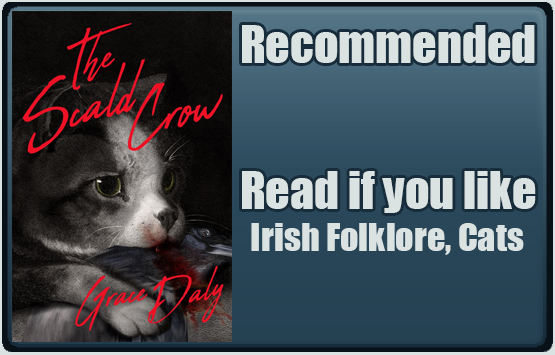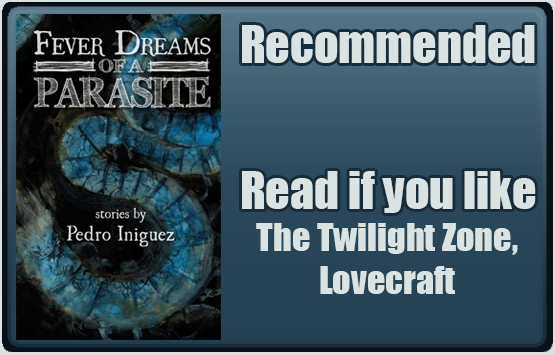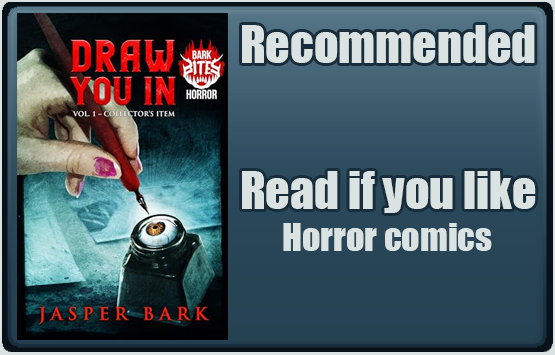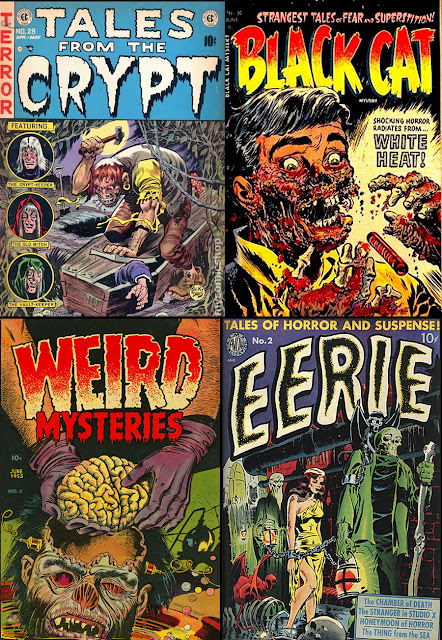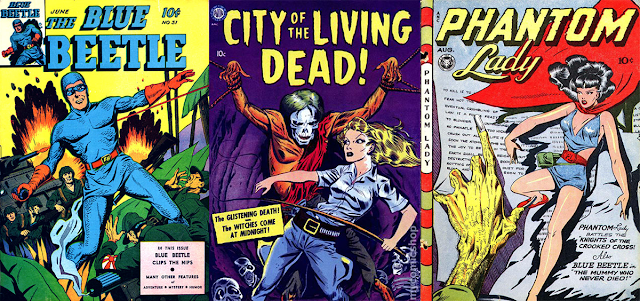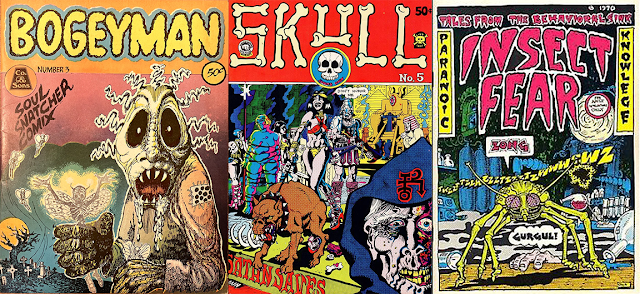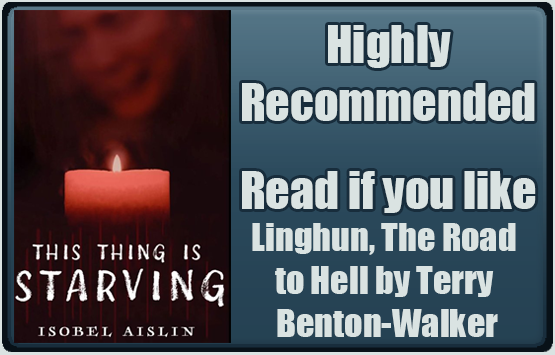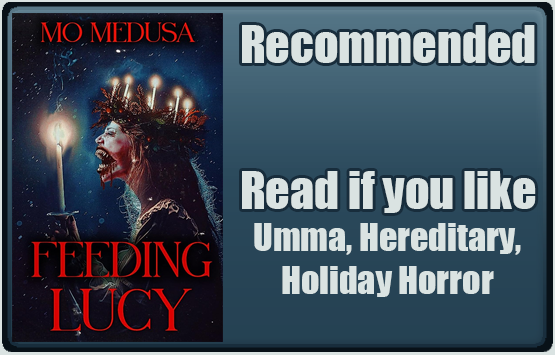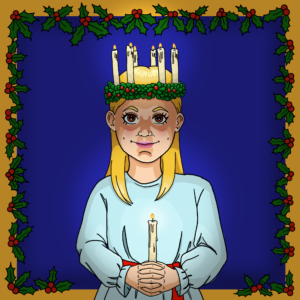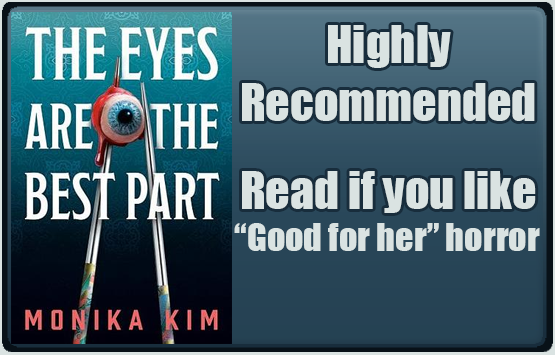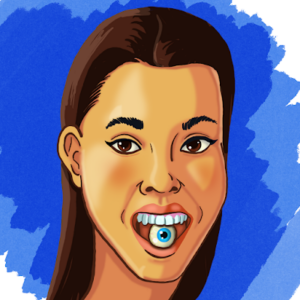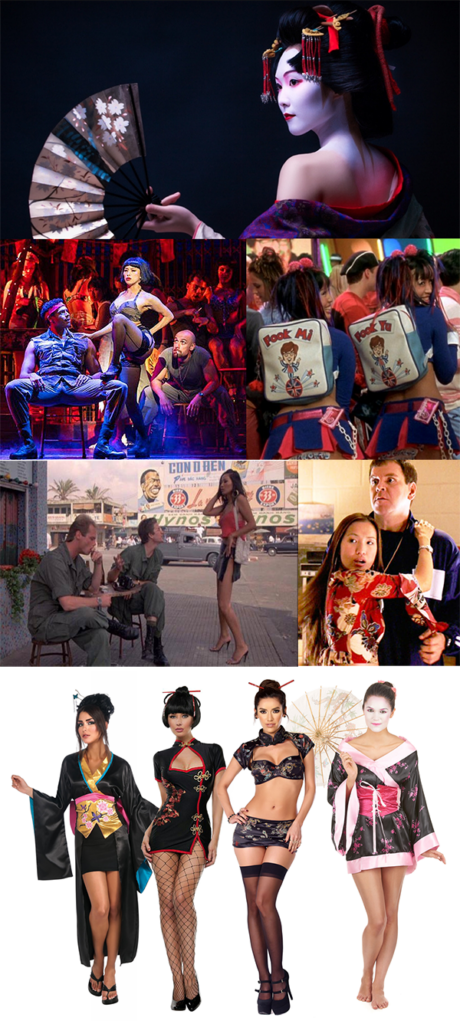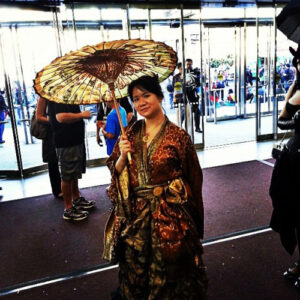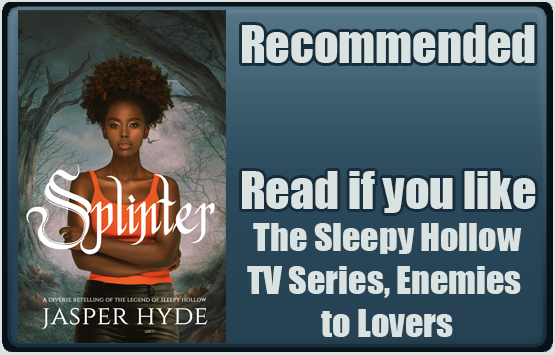Publisher: Creature Publishing
Genre: Myth and Folklore
Audience: Adult
Diversity: Bisexual main character with chronic pain, Black Lesbian side character
Takes Place in: Illinois
Content Warnings (Highlight to view): Ableism, Child Abuse, Forced Captivity, Gaslighting, Illness, Medical Procedures, Mental Illness, Racism, Slut-Shaming, Stalking, Verbal/Emotional Abuse, Victim Blaming, Violence
Blurb
Brigid—that’s the Irish Breej, not “Bridge-id,” though it’s not like she’d correct you—has had a rough go of it. Her mother abused her when she was little, her best friend (and secret crush) is too busy chasing some blonde to answer Brigid’s calls, and she lost her job thanks to chronic pelvic pain with no identifiable cause. As a self-doubting, disabled adult, she’s certain that everything that has happened to her is her fault.
When her mother goes missing and Brigid’s only option is to move back into her childhood home in the idyllic Midwestern town of St. Charles, Illinois, the uncanny begins: A particular crow that once harassed her reappears, following her everywhere. A painting of Jesus keeps coming back, no matter how many times she throws it away. Frozen body parts show up in places rubber band balls and door stoppers ought to be. Every night she dreams that her real mother is dead and decaying in the closet, and the identical mother who raised her is not her mother. But it’s all in Brigid’s head. It’s all her fault. It must be. What other explanation could there be?
To survive, she’ll need to ignore what her mother and her chronic-pain doctors have always told her: that her perception of reality can’t be trusted.
Brigid (who uses the Irish pronunciation “Breej” rather than Anglicized “Bridge-id”) struggles with chronic pelvic pain coupled with IBS that makes it incredibly difficult for her to perform everyday tasks. Due to her chronic pain, Brigid can no longer work, and her disability payments are barely covering the cost of living. She’s on the verge of losing her apartment and becoming homeless (of the hundreds of thousands of Americans who experience homelessness roughly half of them have some form of disability). So, when her abusive mother mysteriously disappears and leaves Brigid her childhood home, she thinks her luck might finally be turning around. Unfortunately, returning to the house not only brings up bad memories for Brigid, but it begins to make her question her sanity as well. Things seem to move around the apartment. Objects she thought she threw out reappear making Brigid question her memory. She finds mysterious meat in the fridge and what, from her description, appears to be a phalange in the garbage disposal.
One day she wakes up to discover garbage spread across the floor and the mysterious piece of meat hanging from the ceiling. Brigid tries to tell the police about the apparent vandalism, but they’re unsurprisingly useless. Strangest of all, a scald crow appears to be following Brigid and spying on her. Scald crows, more commonly known as hooded crows, are found in the UK, so what one is doing in Illinois is anyone’s guess. In Irish folklore the hooded crow, or Badb in Irish, represents the Morrígan, a terrifying goddess of war, sovereignty, and fate. Like the Greek goddess Hecate, the Morrigan is often depicted as a tripartite goddess, three sisters named Badb, Macha, and Nemain. The hooded crow also appears at the death of the demigod Cú Chulainn. Brigid is fascinated by Irish mythology; she remembers reading it with her father before he disappeared, it still brings her comfort on her bad pain days, and she begins to wonder if the crow is more than just a crow. Of course, no one believes her.
Brigid is used to being gaslit, both by her abusive mother and medical providers who question her mysterious pelvic pain. So, when things start getting weird at the house, Bridgid believes it’s all in her head. She also thinks her pain is “all in her head,” even though any decent healthcare provider would tell her that psychosomatic pain doesn’t mean the pain is made up or fake. Unfortunately, as anyone with a chronic condition will tell you, there are a LOT of terrible healthcare providers who treat chronic pain as imaginary. It’s not like on medical TV shows where doctors fight to find a diagnosis and treat the patient no matter what. In the real would, if providers can’t easily diagnose you, they decide you’re no longer their problem or you’re making it up.
My father, a gastroenterologist, often sees patients who have spent years trying to find a diagnosis for their digestive issues before they end up in his office. Most of these patients have seen multiple other specialists who simply gave up on them after discovering they weren’t easy to diagnose. A patient of his told me she spent 10 years looking for a cause of her digestive issues before my dad diagnosed her as having a zoonotic disease from working with swine, something no one else had bothered to test for. Judging by this Reddit thread this is not an uncommon experience for people with chronic illnesses. Brigid has already had one exploratory surgery that came up with nothing, and has pretty much given up any hope of finding a cure for her chronic pain.
Keep in mind people with disabilities are not a monolith, and every individual has a different relationship with their disability. Not every person with a disability wants a cure and assuming all disabilities should be “cured” (i.e. assuming a disability is a defect that keeps someone from being “normal”) is ableist. For example, most autistic people don’t want a cure as autism is not a disease. Many Deaf people feel the same way. Accommodations and addressing ableism are what they want, not a cure. But again, everyone feels differently. Some people may want certain aspects or comorbidities of their disability to go away, but not others. For example, an Autistic friend of mine is perfectly fine with his autism, but hates his anxiety disorder and takes medication to mitigate it. He would be thrilled if his anxiety was cured. But some people with disabilities DO want a cure, and that’s also okay. Brigid’s disability causes her to physically suffer a great deal, and accommodations can’t really mitigate her pain, so she doesn’t like it and wants it gone.
Like many folks with a chronic illness and/or pain, Brigid has a limited amount of energy to get things done and must plan her whole life around her pain flares. She is often too tired by the end of the day to cook anything healthy for dinner and usually just gets a microwave pizza or burrito because that’s all she can handle when her pain gets bad. She must plan her days carefully around her pain, which makes unpacking and cleaning her mother’s house difficult. Spoon theory is a metaphor created by Christine Miserandino to describe the amount of energy a person with a chronic illness has for every day tasks. Each activity costs a certain amount of “spoons.” Simple things like brushing your teeth or watching TV “cost” less spoons while more complex tasks like going to school or work, cleaning the house, or exercising require more spoons. The number of spoons someone has on any given day can vary, so activities need to be planned around the number of spoons available. People with chronic illnesses, pain, depression, etc. have less spoons that someone who is able-bodied and neurotypical,so they need to be especially careful about how they plan their days. They may only have a few spoons on especially bad days, so they need to get as much done as possible on good days. When Brigid’s pain is less severe, she tries to get as much cleaning and unpacking done as possible, even though it will make her pain worse later.
Brigid doesn’t just have physical symptoms to contend with. She also struggles with trauma from the emotional abuse she endured from her mother for years. Brigid thinks she’s unlovable and deserves the abuse from Mammy because she was a “difficult” child. This has left her with a lot of shame and self-hatred. Her friend, Emma, points out that, in truth, Brigid is too agreeable and will go along with anything, even if it hurts her. Brigid’s people pleasing along with her lack of self-compassion are both common in abuse survivors. Brigid doesn’t recognize what happened to her as abuse, however, since it was never physical.
Brigid often dreams that an evil mother came and killed her “real” mother, who used to be kind and loving. There’s a Freudian theory that a child can’t comprehend her previously loving and kind mother becoming cruel and abusive, so she thinks her mother has been replaced somehow. In Bruno Bettelheim’s The Uses of Enchantment: The Meaning and Importance of Fairy Tales the author argues that children separate their mother into their “good” mother (when she’s kind and nurturing) and “bad” mother (when she punishes them or doesn’t give them what they want). This is represented in Grimm’s Fairy Tales by the usually deceased good mother, and the wicked stepmother, who provides a transference object for the child’s hate.
Brigid’s mother being replaced by a bad version also brings to mind the story of changelings. In European folklore, a changeling is supernatural substitute that was left by fairies, demons, elves, or trolls in place of a human, usually a child. In Ireland, the belief in changelings continued to endure at least as late as 1895, when Bridget Cleary, who worked as a dressmaker, was murdered by her husband, Michael Cleary. At his trial Michael claimed that his wife had been replaced by a fairy and he had to burn the changeling alive to get his wife back. If you’re a fan of Aaron Mahnke, episode 11 of his podcast, Lore, tells the story of Bridget Cleary (I highly recommend it).
There’s a modern theory proposed by such scholars as D. L. Ashliman, Lorna Wing, and Davids Potter that the changeling myth arose as a way to explain neurodivergence or other disabilities in children. Unfortunately, this could lead to abuse and even infanticide as parents believed the child was not their own. In 1826, again in Ireland, Ann Roche drowned her four-year-old grandson, Michael Leahy, believing him to be a changeling because he could neither speak or stand. Roche believed that holding him under water would cast out the fairy which would allow her grandson to act like a “normal” child. Sadly, even today, children with disabilities are at least three times more likely to be victims of abuse or neglect than children without disabilities (and the number may actually be higher due to many children with disabilities being unable to directly report). When children with disabilities are murdered by their caregivers people will often excuse the murder and paint the murderers as victims because their child was a burden. Moral philosopher and terrible human being Peter Singer argued in his book Practical Ethics (1979), that it is morally justified to kill babies with disabilities. He also claims that it’s totally okay to kill a baby with a disability if the parents replace them with a non-disabled baby.
“When the death of a disabled infant will lead to the birth of another infant with better prospects of a happy life, the total amount of happiness will be greater if the disabled infant is killed. The loss of happy life for the first infant is outweighed by the gain of a happier life for the second.”
Gross. Sadly, Brigid has internalized the belief that her disability makes her “a burden,” despite what her therapist and best friend tell her.
I liked that Brigid’s Black best friend and crush, Emma, was not relegated to the role of “just there to support the white girl with no needs of her own.” When Brigid was relying too much on her for emotional support Emma was quick to set a boundary and tell her BFF (not unkindly) that this was probably something better discussed with her therapist, Carol. Emma makes time for Brigid, but isn’t always available when she calls, as Emma is busy with her own life which includes romantic turmoil, pottery class, dealing with the rich white parents she nannies for, and her beloved cats. She will even call Brigid for support when she’s struggling with her love life, so the friendship doesn’t feel one-sided (even if Brigid, in her insecurity, worries that it is).
I also appreciated that although Emma works as a nanny for rich white people, she does so without falling into the harmful Black mammy (not to be confused with what Brigid calls her mother) trope. She does the work because she’s paid well (very well) by wealthy parents, but still recognizes the inherent racism in liberal white parents hiring a Black nanny so their kids will respect other races while also expecting her to do the work they consider below them. Emma is a curvy woman, but not desexualized at all. In fact, Brigid often remarks on how stylish and sexy she is. Again, Daly could have made Emma little more than a trope, this time the Jezebel, but manages to avoid it by making Emma a well-rounded character. She is more likely to speak her mind than Brigid, but isn’t “loud and sassy,” and struggles with her own insecurities. Although Emma doesn’t appear often in the book, she still gets her own romantic storyline, and even some character development when she recognizes she’s being biphobic by refusing to date women who have only dated men before. I’m also happy to report that “Black” was always capitalized when talking about race.
I loved Daly’s dark sense of humor because sometimes all you can do is laugh about it when things are terrible, as Brigid often does to deflect. I also loved Brigid’s character, felt strongly for her, and wanted so badly for her to have a happy ending, even though I know those are rare in real life. The pacing is a little slow in the beginning compared to the end, but that’s really the only criticism I have. This story is not for the squeamish, as Brigid suffers from both gastrointestinal distress and difficult periods and both are described in painful detail. Honestly, I appreciated that Daly did not shy away from talking about poop and menstrual blood as it let the reader see the full extent of what Brigid goes through on a daily basis. As someone with my own pelvic and digestive problems (that are thankfully nowhere near as severe or painful as Brigid’s) it was refreshing to see symptoms I’ve experienced myself described without shame. Scald Crow was one of those books that managed to made me laugh out loud, choke back tears, and shiver with apprehension. Definitely a fun and spooky read.
